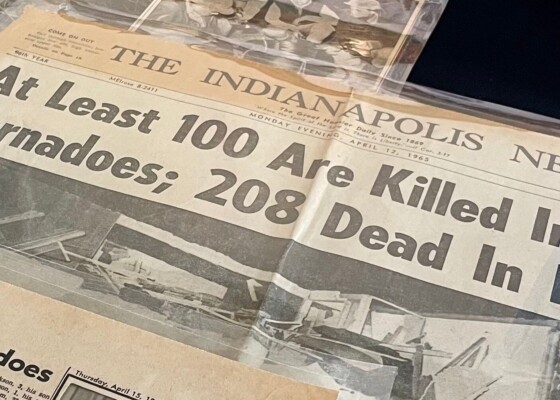INseparable Suburbia
March 16, 2020Hulu’s miniseries Little Fires Everywhere premieres this month, giving us a great opportunity to think about how we cross divides like class and race, as well as how we traverse…
Hulu’s miniseries Little Fires Everywhere premieres this month, giving us a great opportunity to think about how we cross divides like class and race, as well as how we traverse the geographical middle ground that is the American suburb. Starring Kerry Washington and Reese Witherspoon, the show centers on the well-to-do Richardson family and how their lives are transformed by the arrival of an enigmatic mother and daughter who rent their spare apartment. It is based on the 2017 bestselling novel of the same title by Celeste Ng.
Spanning issues of motherhood, transracial adoption, art and photography, teenage pregnancy, class divisions, and more, Little Fires Everywhere is an absorbing picture of two families and the obstacles they must overcome for the ones they love. Part of what makes the story so gripping is its backdrop: Taking place in the mid-1990s just outside Cleveland in a planned community known as Shaker Heights, the location of the TV show and book is a heavily zoned, rules-based suburb that becomes another character in the novel.
Elena Richardson (played in the TV show by Reese Witherspoon) is the perfect representative of this suburban community. She is loving, generous, and more likely to choose security and tranquility over ambition and exhilaration. Many of the Shaker Heights homes appear similar on the outside, whether they are single-family homes like the idyllic Richardson house or duplexes like the one that Mia Warren (played by Kerry Washington) and her daughter Pearl rent from the Richardsons. Similarly, Elena maintains a well-manicured façade that begins to crack as Mia and Pearl shake up the seeming calm of her neighborhood.
The drama heightens as Shaker Heights becomes wrapped up in the fate of a Chinese baby adopted by a white family, who also happen to be Elena’s friends. The baby at the center of the adoption battle—known as Mirabelle McCullough to her adopted parents and as May Ling Chow to her birth mother Bebe—becomes the catalyst that sparks life-changing confrontations between the Richardson family and Mia and Pearl, exposing some of the hidden limits of this outwardly welcoming suburb.
In the book, When American Became Suburban, Robert Beauregard tracks how the rise of the suburb after World War II reflected the United States’ arrival on the world stage. He notes that images of US suburban life solidified a view of the nation that was appropriate to its “status as the leader of the ‘free world’ and established the country’s economy and form as the best hope for affluence, democracy, and world peace. Life in the suburbs was a mark of American exceptionalism and a model to which all nations could aspire.” In other words, the best of the United States and the pinnacle of the American dream could be found in its suburbs.
In many ways, the Shaker Heights of Little Fires Everywhere meets and even exceeds these criteria. The town is prosperous and progressive, and the Richardsons as its representatives are mostly caring, thoughtful, and kind. There are, despite the titular arson that opens the novel, no real villains in Ng’s book. Even most of those who fumble do so more to misguidance or lack of knowledge rather than out of any intentional malice.
Evocative of the multicultural celebrations that marked the 1990s, one of the Richardson teenagers, Lexie, contemplates her neighborhood and proclaims, “I mean we’re lucky. No one sees race here.” While readers are meant to see the irony in her comment, Ng—who grew up in Shaker Heights, does feel that diversity was welcomed there, and even recalls being given racial awareness training in elementary school. At the same time, however, events such as the May Ling Chow/Mirabelle McCullough trial prove that good intentions may not be enough to help us unlearn our privilege or overcome our biases. In this way, for better or worse, the suburbs really do show us who we are.
Last year, the real-life community of Shaker Heights ranked in one study as the 12th best suburb in the country and the second-best place to live in Ohio. (If you’re wanting to know which suburb ranked first, by the way, it was Carmel.) Part of the reason for Shaker Heights’ success has to do with its origins; the town’s founders planned everything with a mind to utopia. Ng, who sculpted miniatures before she became a full-time writer, has an exacting eye that captures this utopia in minute detail.
However, when I think of the Cleveland suburbs, two places come to mind. The first, of course, is Shaker Heights. The second is East Cleveland, a suburb north of Shaker Heights and the site of many episodes of the popular documentary podcast Serial, whose third season discusses issues such as sentencing, probation, and juvenile justice. The hosts, Sarah Koenig and Emmanuel Dzotsi, chose Cleveland because they felt it would be a good representative of justice systems across the nation. Their coverage of the suburb of East Cleveland exposes, among other things, how nearly impossible it is to access government records and how courts handle police misconduct. Thinking of both East Cleveland and Shaker Heights, one might be hard-pressed to find two more contrasting images of suburbs.
East Cleveland, by the way, is only a 20-minute drive from Shaker Heights.
As you watch the TV show version of Little Fires Everywhere and/or read Celeste Ng’s wonderful novel, think about how suburbs crystallize both our differences and the ways we might overcome them. How do we empathize with others, especially those who differ from us in terms of class, race, and upbringing? The story asks us to consider this question, and how much patience, generosity, and hard work is required to find its answers.


